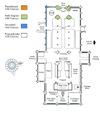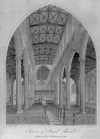For this church:    |
Newark St Mary MagdaleneHistoryThe Development of the church building
In medieval times Newark was one of the largest towns in Nottinghamshire, and its parish church reflects this. A church stood on the present site in Saxon times but nothing of this remains. The earliest parts of the present church, the crypt and the four piers at the transept crossing, date from about 1180 and are all that remains of the Transitional Norman church. The lower stage of the tower dates from c.1220 and the south aisle and spire were added in the early fourteenth century. The nave arcade, clerestory and north aisle date from the mid fifteenth century, while the chancel, choir aisles and retro-choir were completed in the late fifteenth century. The transepts, vestry and porches date from the first quarter of the sixteenth century. HistoryIn the eleventh century Lady Godiva had given the income of her manor of Newark to Stow monastery near Lincoln. After the Norman Conquest the endowment with the advowson of the church passed to the Bishop of Lincoln and in the twelfth century Robert de Chesney, Bishop of Lincoln, gave the church to the Gilbertine priory of St Katherine outside Lincoln and the latter retained control until the Reformation, providing vicars from among their own brethren. Although subject to the Bishop of Lincoln as Lord of the Manor, Newark with the rest of Nottinghamshire lay in the diocese of York and this resulted in much tension as both ecclesiastical overlords and the Prior of St Katherine’s attempted to impose their own wills on the town and church. Sometimes this resulted in violence, as in 1426, when a mob incited by representatives of the Archbishop of York, made a riot in the church, assaulting the vicar, Thomas Marshe. The chief benefactors of the church in mediaeval times were the wealthy wool and cloth merchants based in Newark. Not only did they provide much of the fabric and furnishings, they, together with the religious guilds also established about twenty chantries, of which only two chapels remain - the Meryng and Markham chapels to the north and south of the High Altar. At the beginning of the sixteenth century the chancel received choir stalls and rood screen, the latter thought to be by Thomas Drawswerd of York (and maybe the only surviving example of his work). In the seventeenth century the church tower served as a look-out point for the Newark garrison during the Civil War sieges and the spire still bears a cannon-ball hole. After the capitulation of the town, on the orders of Charles I himself, Parliamentarian soldiers are said to have stabled their horses in the church and the font was certainly damaged, later to be re-built by the charity of Nicholas Ridley. Most of the stained glass windows which had survived the Reformation were destroyed at this time, though fragments were gathered together and can now be seen in the east window of the south choir aisle, re-arranged by Miss Joan Howson of Oxford University in 1957. By the end of the eighteenth century the church had been filled with high sided box pews and galleries (arranged in a haphazard fashion) which had been installed over the north and south aisles, north and south transepts, as well as the west end of the church, between north and south porches. On the latter gallery the GP England organ was positioned for a time (1804-1814) before being removed to the top of the rood screen. During this century the church was again the scene of riots, this time between rival factions taking part in the churchwardens’ elections. The churchwardens exercised great power in the administration of the town’s many charities.
In the 1850s a great restoration was undertaken, instituted by the vicar, Rev JG Bussell, and carried out by the architect Sir George Gilbert Scott. All the galleries and box pews were removed, the organ was rebuilt by Forster and Andrews, and the former altar-piece (The raising of Lazarus, by William Hilton) was replaced by a reredos depicting scenes from the life of St Mary Magdalene, designed by Scott. During the twentieth century the church has undergone two major restorations: in the 1960s, when the stonework was cleaned and renewed where necessary, and the ceiling painted; and in the 1970s when the monuments were restored and a platform installed in front of the rood screen to accommodate a nave altar and facilitate concert performances. At this time the organ was rebuilt and is now operated by the Ellen Dynamic Transmission System. In 1981 the crypt was converted into the Treasury to house St Mary’s own church plate and also items from elsewhere in the diocese. In 1991 the west end of the north aisle was converted into a hospitality area and kitchen facilities were installed. In 1999 the Victorian pews were removed from the transepts to provide meeting and quiet areas and to accommodate modern needs. The Development of the ParishUntil the nineteenth century Newark had only one parish - that of St Mary Magdalene. However, with the increase in population in the nineteenth century St Mary’s could no longer accommodate the increasing population of the town and in 1835 the first of the two daughter parishes was established. This was Christ Church which included the area to the south of the town and was served by a church in Lombard Street. In 1873 St Leonard’s parish was formed to serve the north eastern side of the town, with its church in Northgate. In addition three mission churches were established: St Augustine’s, Newton Street, St Agnes’, Beacon Hill and Tolney Lane Mission across the river. By the 1950s the expansion of the town’s housing estates meant that Christ Church and St Leonard’s were no longer near the majority of their parishioners. In 1958 a new Christ Church was built on Boundary Road, on a site near the centre of the growing parish it serves, and in 1977-78 a new St Leonard’s church was built on Lincoln Road. The old Christ Church passed into secular use and the old St Leonard’s was demolished. By the 1960s, with the fall in church attendance in accordance with national trends, the mission churches were no longer required. Tolney Lane Mission was closed in 1963, St Agnes’, Beacon Hill, in 1969 and St Augustine’s, Newton Street, in 1998. During the twentieth century the Newark benefice has been linked with various local parishes. In 1923 Newark was joined with Coddington and Barnby and in 1961 the union was dissolved and Newark was linked with Hawton, Cotham and Shelton. In 1989/90 Shelton joined Elston while Hawton and Cotham joined Farndon. In 1980 the Newark Team Ministry was established, by which the Vicar of St Mary’s became Team Rector of the Parish of Newark (with Hawton, Cotham and Shelton) and the clergy at Christ Church, St Leonard’s and Hawton became Team Vicars. |







